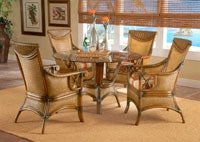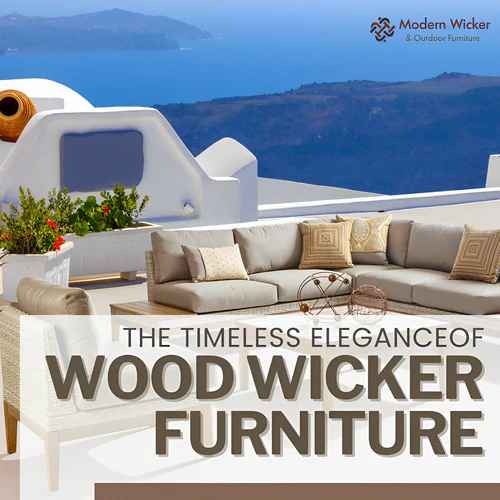Rattan vs wicker furniture, how do they stack up, and which one is best for you? While they may look and even feel the same, both furniture types do have significant differences. Some of these differences even extend past the realm of aesthetics.
Read on to learn what rattan and wicker are, how they differ and resemble each other, and get some furniture recommendations.
What Is Rattan?
Rattan is a durable and flexible material derived from tropical vines. It boasts natural beauty with warm tones and organic texture. Indigenous to tropical regions, rattan is cultivated sustainably without harming the environment. This makes it a solid eco-friendly choice for anyone worried about deforestation.
Rattan furniture inherits the durability, versatility, and lightweight properties of its main build material.
This is why Rattan is commonly used to create:
- Chairs
- Tables
- Sofas
- Decorative items
Rattan's natural charm suits different design styles, making it ideal for creating a tropical oasis or adding an organic touch to contemporary interiors and the perfect complement to wicker wood furniture. We’ve listed an item that best exemplifies rattan’s key qualities.
South Sea Rattan Bermuda Indoor Lounge Chair

This South Sea Rattan Bermuda Chair effectively showcases the natural beauty and eco-friendly charm of rattan furniture. This lounge chair sports a solid framing constructed from natural rattan. It has a natural peel, and you can even decide what leather wrapping you prefer.
Your two choices are either a scratch-resistant Pecan or a similar Whitewash finish. Your floor will also be protected thanks to the non-marking feet of this chair. Fortunately, you won’t have to assemble a thing as the entire lounge chair comes fully assembled.
What Is Wicker?
Wicker is a weaving technique or style used in furniture production. It involves weaving natural or synthetic fibers to create intricate patterns and textures.
Materials commonly used in wicker production include:
- Rattan
- Bamboo
- Willow
- Synthetic fibers like resin or PVC
Wicker furniture is lightweight, making it easy to move and versatile for both indoor and outdoor use. Its natural, rustic charm adds elegance to spaces. Wicker finds common applications in:
- Chairs
- Tables
- Sofas
- Storage units
- Decorative items
Whether on a patio or inside a home, wicker furniture seamlessly blends with various design styles, adding a touch of natural beauty to any setting.
Forever Patio Universal Woven Bar Height Table

Why not hold your patio or room together with a Forever Patio Universal Woven Bar Height Table? This premium weave offering is made with high-density Polyethylene all-weather wicker. What this means is that the table itself won’t crack or fade due to long-term exposure to the sun.
Heavy rain also won’t pose as much of a problem thanks to its build.
The table top is tempered glass covered, and it’s backed by a sturdy aluminum frame. This aluminum frame is thick-gauged and powder-coated. What these two features do is raise the frame’s rust resistance and durability.
Rattan Versus Wicker: Key Differences
Rattan versus wicker is a true showdown between natural elegance and weaving wonders! Let's dive into the key differences between these two charming furniture options. Knowing what sets them apart will help us understand which one fits our needs more.
Build Composition of Rattan vs Wicker Furniture
Let's talk about material composition and construction. Rattan takes the spotlight here, being an organic and all-natural material. It's derived from a tropical vine, lending a touch of Mother Nature's beauty to your furniture pieces.
As we’ve already gone over, wicker isn't a material itself but rather a weaving technique or style. It can be applied to various materials, including rattan, bamboo, willow, and even synthetic fibers.
While rattan furniture is exclusively crafted from rattan, wicker furniture simply offers a broader range of material choices.
Is Rattan or Wicker More Durable and Stronger?
The build composition of these furniture types directly contributes to their durability. With this in mind, it becomes easier to understand why rattan furniture takes the crown in the durability department. It is important to know, however, that rattan material does boast impressive resilience.
Wicker furniture, however, varies in durability depending on the material used. While rattan wicker offers sturdiness, wicker made from delicate materials may be better suited for indoor use, offering a touch of delicate beauty.

When it comes to durability, what matters most is what materials a piece of wicker furniture is using.
Flexibility and Versatility of Wicker vs Rattan Furniture
Flexibility and versatility are where both rattan and wicker shine. Rattan furniture is highly flexible, allowing artisans to create intricate designs and shapes that will leave your guests in awe. On the other hand, wicker furniture, regardless of the material used, offers a world of possibilities.
The weaving technique allows for a diverse array of patterns and designs, ensuring there's a wicker piece for every style preference.
Wicker vs Rattan: Maintenance
When it comes to maintenance, both rattan and wicker furniture require some attention and care.
- Rattan furniture may need occasional cleaning and protection from direct sunlight to prevent drying and cracking.
- As for wicker furniture, specific care instructions may vary depending on the material used.
Whether it's natural rattan wicker that needs a little dusting and protection from moisture or a synthetic wicker that's more resistant to the elements, proper care ensures your furniture's longevity.
Wicker vs Woven Wicker Aesthetics
Aesthetically speaking, rattan furniture celebrates the organic beauty of the rattan material. With its natural texture and warm tones, it exudes an earthy charm. Wicker furniture, however, offers a more diverse aesthetic playground.
Depending on the chosen material, it can range from natural and rustic to sleek and modern, allowing you to find the perfect fit for your unique style.
In the lively contest of rattan versus wicker, the winner ultimately depends on your preferences and needs. Rattan brings the allure of a natural material, showcasing the beauty of the tropics, while wicker unveils the artistry of weaving, offering a versatile range of styles.
Wicker Versus Rattan: The Similarities
Despite their many differences, these two furniture types have a few similarities. It’s time to discuss the benefits or qualities that both furniture types share. This will help us further understand what it is that we are looking for before making a purchase.
Popular Choices for Outdoor and Indoor Settings
One commonality between wicker and rattan is their popularity in both outdoor and indoor settings.
Wicker furniture, with its lightweight nature, is often chosen for outdoor spaces such as patios, gardens, and balconies. Its durability and resistance to weather conditions make it a reliable option for outdoor use.
Rattan furniture is also well-suited for outdoor settings, as it can withstand exposure to the elements with proper care. However, both wicker and rattan furniture are equally loved for their indoor applications, bringing a touch of natural beauty and warmth to living rooms, dining areas, and sunrooms.
Environmental Considerations
Both wicker and rattan offer eco-friendly choices for furniture enthusiasts.
- Rattan is a sustainable material as it comes from a fast-growing vine that can be harvested without causing harm to the environment. This makes rattan a renewable resource, reducing the strain on natural forests.
- Wicker furniture made from materials like bamboo or willow can also be environmentally friendly, as these materials are renewable and easily replenished. Opting for wicker or rattan furniture allows you to enjoy stylish pieces while making a conscious choice for the planet.
Integration With Different Design Styles
Whether you have a coastal-themed living room, a bohemian-inspired bedroom, or a modern minimalist space, both wicker and rattan furniture can complement and enhance the overall aesthetic.
The natural textures and earthy tones of these materials bring a sense of warmth and organic beauty to any design scheme.
Either choice not only adds charm and functionality to your space but also aligns with an eco-conscious mindset and varied design preferences.
Choosing Between Rattan vs Wicker Furniture
Choosing between rattan and wicker furniture requires careful consideration of several factors. These should include durability, maintenance requirements, and comfort.
Consider how suitable each option is for different environments and purposes, whether you want it for outdoor use or indoor settings. Personal preferences and style considerations play a significant role in the decision-making process. This way, you can ensure that the furniture aligns with your desired aesthetic and design scheme.
Budget considerations are also essential. Since rattan and wicker furniture can vary in price range, allow yourself to find an option that fits your budget while meeting your requirements.
Wicker vs Rattan Furniture: Which One Is Best for You?
Both furniture types give you an eco-friendly piece that can tie any room together. However, the best aesthetic for your needs may vary from one person to the next. Do you prefer rattan furniture’s earthy tones or wicker furniture’s rustic feel?
If you can’t decide, contact us. We can help you get a compatible furniture set fit for your needs with a quick phone call.










